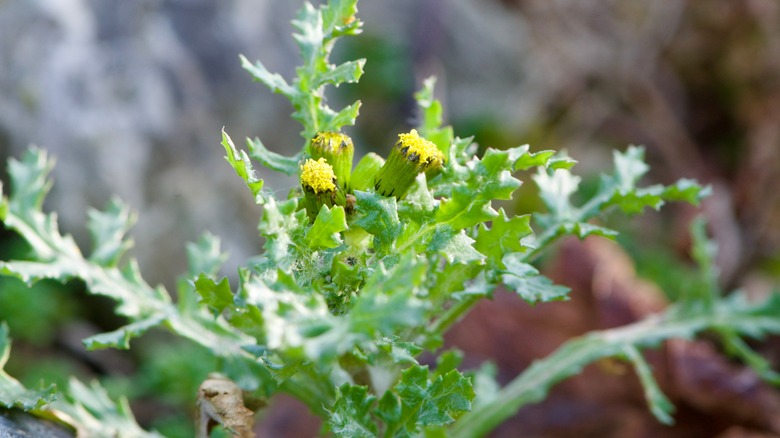The Fast-Spreading Weed That Can Do Major Damage To Vegetables In The Garden
Second to pests, weeds are probably the most annoying thing that creep up in your yard, threatening to destroy the lawn and flowers you have so carefully planted and cared for. Getting rid of weeds is a chore not many gardeners look forward to, but it has to be done to ensure the health of everything that grows in your garden. Common groundsel (Senecio vulgaris) is a fast-spreading and dangerous weed that isn't just harmful to your garden but is also a threat to animals and people.
Native to Europe, Asia, and North Africa, common groundsel is believed to have arrived in America when European settlers arrived and brought it along with their grain. It is commonly found in parts of North America and spreads very fast — the origin of its name comes from an Anglo-Saxon word meaning "ground swallower". Common groundsel likes to creep up along the edges of walls near lawns and sunny gardens. It can also be found in cultivated lands. Common groundsel can be identified by its green deeply lobed leaves with toothed margins that can turn a darker purple color and grow up to 4 inches long. The plant itself can grow up to 18 inches tall and bloom with clusters of yellow rayless flowers. While it is a winter annual or biennial, they can germinate and be spotted throughout the year.
Why common groundsel is so dangerous
Common groundsel is able to spread so quickly because its puffy white seed heads spread their seeds by floating in the wind. The seed heads from one plant can produce as many as one million seeds a season, making them a nightmare to get rid of. Common groundsel contains pyrrolizidine alkaloids which can cause irreversible liver and kidney damage and even heart failure in both humans and animals. It also poses a risk to crops because it carries the Thielaviopsis basicola fungus that causes black root rot in planted vegetables such as carrots and peas, making them toxic to animals and humans. Avoid eating vegetables that were grown near common groundsel if you suspect they may be contaminated.
Removing common groundsel is key for the health of your garden and the safety of living creatures who spend time in your yard. While tilling and hoeing might seem like the simplest option, not everyone might have the time or want to do that kind of back-breaking work. Even if you can manage to cut common groundsel or pull it out by its root, it can still come back stronger if seeds from their mature flowers or fluffy seed heads find their way back into your garden by wind or through your compost.
How to control common groundsel
Some DIY weed killers like vinegar-based solutions might offer a natural alternative to herbicides and while this might help slow down the spread of weeds, the best way to decrease the chance of common groundsel coming back is by rooting it out before it can flower. Another unusual approach does exist, though. Cinnabar moth caterpillars feed on common groundsel and can eat and kill the weeds before they are able to seed. You're welcome to try this move if you're desperate, but it would be counterproductive since the caterpillars wouldn't eat the weeds exclusively. However, these caterpillars are not available year-round and their vulnerability to predators makes this an unreliable solution.
Regular general maintenance of your garden will allow you to keep a close eye on your plants so you will be able to spot an intruder in your garden earlier. If you have no problem using chemicals to deal with stubborn and troublesome invasions, herbicides containing a glyphosate solution can be administered by a professional. This is especially helpful in areas with a much larger common groundsel invasion.


